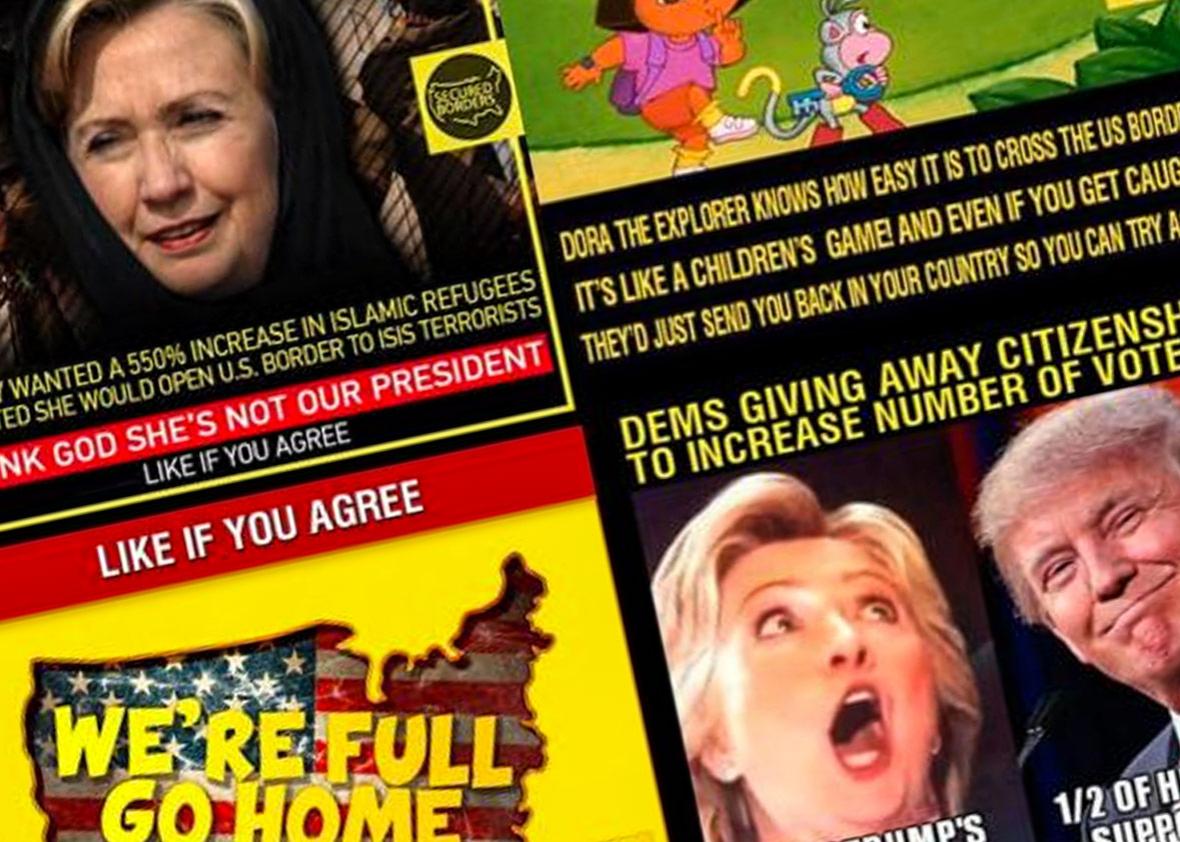On Thursday, many of us were distracted by the Federal Communications Commission’s vote to repeal net neutrality rules. But something good happened at the end of the week, too: The Federal Election Commission determined that political ads with images or videos posted on Facebook now have to include disclaimers about who paid for them. It was the first time the FEC had clarified its federal rules for posting political ads on Facebook in six years. Candidates spent more than $1.4 billion in the 2016 election on online political ads, so this decision could actually shake things up in advance of the 2018 midterms.
On television and in print, ads that are for or against a particular candidate must include a disclaimer about who pays for them. But as of 2011, online ads were largely exempt from this requirement, because—according to internet companies—they were too small to include additional information. The question gained new importance earlier this year after Facebook disclosed that Russian agents linked to the Kremlin–backed Internet Research Agency ran an extensive campaign over U.S. social media companies in an effort to sway the 2016 election and stoke political unrest.
“Many of the Facebook ads that Russia bought before the 2016 election didn’t include any disclaimers abut who paid for them,” said Brendan Fischer, the director of FEC reform at the Campaign Legal Center, a nonpartisan organization based in Washington. Disclosures won’t fix everything, of course. For instance, super PACs commonly take on benign names to conceal the source of their funding and motives. “If Russia had included a disclaimer on its political ads, it may have only included information on a popup group set up to buy the ads,” he admitted. “But that disclaimer information still could have provided the breadcrumbs for the public to find out where these messages came from.”
Facebook, Google, and Twitter came under fire in October and November this year as unhappy members of Congress began to investigate how Russian agents used their online ad tools to manipulate voters in the run-up to the 2016 election. In response, the platforms all scrubbed content they identified as originating from Russian agents. That included thousands of ads from Facebook, more than 1,000 videos from YouTube, and thousands of Twitter accounts. The content from Facebook alone reached 126 million people over the past two years, according to the company.
The FEC’s decision was sparked by an inquiry sent by a conservative political group called the Take Back Action Fund, which asked whether the Facebook ads that it plans to run in the next election cycle should include a disclaimer about who paid for them. The FEC said that if the Facebook ads include images or videos, then they need information about who paid for the ad and whether it is endorsed by a particular candidate, according to Fischer.
In 2010, Google argued that many of the political ads it runs should be exempted as “small items”—similar to a bumper sticker or a text message—that aren’t subject to the same disclosure rules. Google ultimately was allowed to run its short election ads without a disclaimer, but the FEC did conclude that the ads would need to link to a landing page that you could click to find out who paid for it. The next year, in 2011, Facebook tried to take the exception a step further, arguing small online election ads shouldn’t even be required to include a link to a landing page with a disclaimer. The FEC was left in a 3–3 vote split on party lines, with the three Democratic commissioners voting against Facebook’s proposal. Because of the deadlock, Facebook basically assumed that it wouldn’t face penalties for running ads without links to disclaimers, former FEC Commissioner Ann Ravel explained in an interview with Slate in early October.
The Interactive Advertising Bureau, a trade group that counts Facebook, Twitter, and Google as members, testified in front of Congress at the end of October to call for a self-regulatory approach to online political ad disclosure. Randall Rothenberg, the president of the IAB, suggested that digital media companies could “police their supply chains for bad actors and provide greater transparency into who is putting what into their sites.” As it became clear that a crackdown was coming, the Internet Association—another lobbying group whose members include Facebook and Google—suggested in a letter last Thursday that a link to a landing page of the group that paid for the ad, instead of putting the information on that ad itself, would suffice. But clearly the FEC didn’t agree.
In October, in what may have been an attempt to dodge new regulatory requirements, Facebook and Twitter both unveiled online transparency tools to help users know more about where their political ads are coming from. Facebook’s do-it-yourself approach included an initiative to show users all the ads that a particular Facebook page buys. Twitter’s plan included a new online dashboard that will ostensibly show who bought the ad, how long its been running, and how the ad was targeted. Neither tool appears to be live yet, though. Political ads on Twitter will also be marked with a special indicator to set it apart from other ads on the platform, the company said in a blog post.
Last month, after receiving more than 150,000 comments about whether it should start a process to update its political ad disclaimer requirements, the FEC said it would begin to draft a new proposal. Still, there’s little indication that the agency will move fast enough to get its new rules in place before election season next year.
